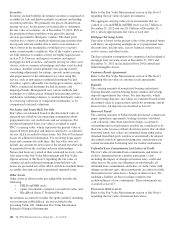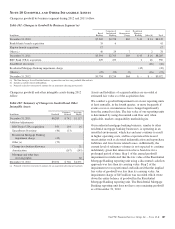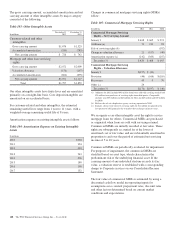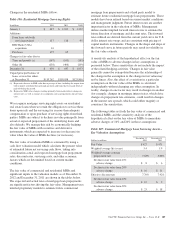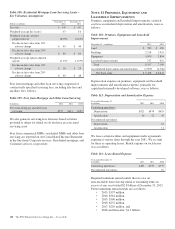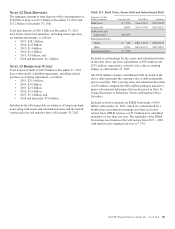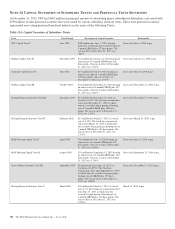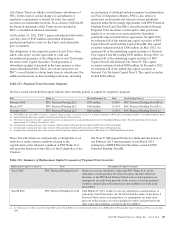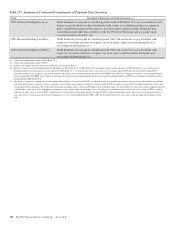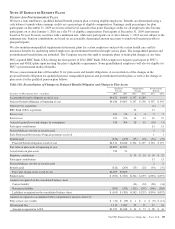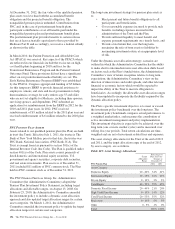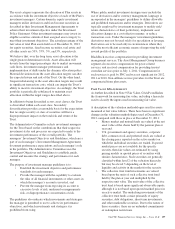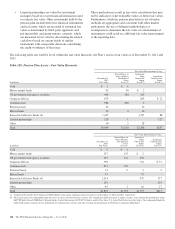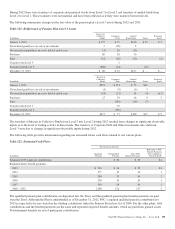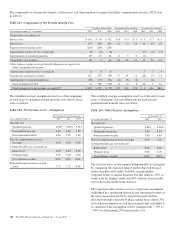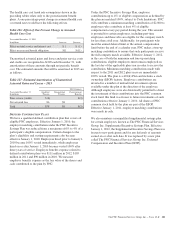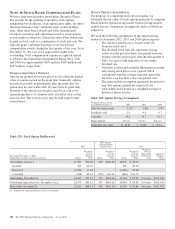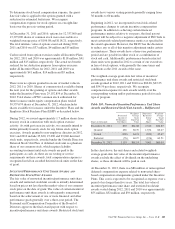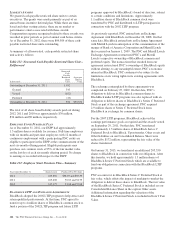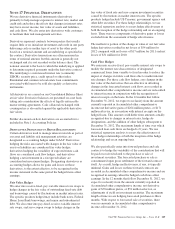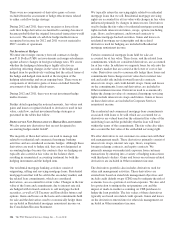PNC Bank 2012 Annual Report Download - page 215
Download and view the complete annual report
Please find page 215 of the 2012 PNC Bank annual report below. You can navigate through the pages in the report by either clicking on the pages listed below, or by using the keyword search tool below to find specific information within the annual report.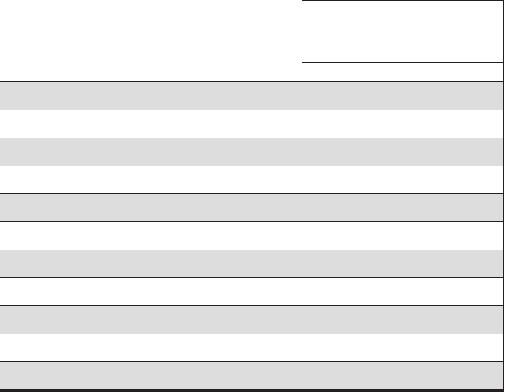
At December 31, 2012, the fair value of the qualified pension
plan assets was less than both the accumulated benefit
obligation and the projected benefit obligation. The
nonqualified pension plan is unfunded. Contributions from
PNC and, in the case of postretirement benefit plans,
participant contributions cover all benefits paid under the
nonqualified pension plan and postretirement benefit plans.
The postretirement plan provides benefits to certain retirees
that are at least actuarially equivalent to those provided by
Medicare Part D and accordingly, we receive a federal subsidy
as shown in the table.
In March 2010, the Patient Protection and Affordable Care
Act (PPACA) was enacted. Key aspects of the PPACA which
are reflected in our financials include the excise tax on high-
cost health plans beginning in 2018 and fees for the
Transitional Reinsurance Program and the Patient-Centered
Outcomes Fund. These provisions did not have a significant
effect on our postretirement medical liability or cost. The
Early Retiree Reinsurance Program (ERRP) was established
by the PPACA. Congress appropriated funding of $5 billion
for this temporary ERRP to provide financial assistance to
employers, unions, and state and local governments to help
them maintain coverage for early retirees age 55 and older
who are not yet eligible for Medicare, including their spouses,
surviving spouses, and dependents. PNC submitted an
application for reimbursement from the ERRP in 2012 for the
2010 and 2011 plan years. In 2012, PNC received
reimbursement of $.9 million related to the 2011 plan year and
received reimbursement of $.6 million related to the 2010 plan
year.
PNC P
ENSION
P
LAN
A
SSETS
Assets related to our qualified pension plan (the Plan) are held
in trust (the Trust). Effective July 1, 2011, the trustee is The
Bank of New York Mellon; prior to that date, the trustee was
PNC Bank, National Association, (PNC Bank, N.A). The
Trust is exempt from tax pursuant to section 501(a) of the
Internal Revenue Code (the Code). The Plan is qualified under
section 401(a) of the Code. Plan assets consist primarily of
listed domestic and international equity securities, U.S.
government and agency securities, corporate debt securities,
and real estate investments. Plan assets as of December 31,
2011 included $11 million of PNC common stock. The Plan
held no PNC common stock as of December 31, 2012.
The PNC Financial Services Group, Inc. Administrative
Committee (the Administrative Committee) adopted the
Pension Plan Investment Policy Statement, including target
allocations and allowable ranges, on August 13, 2008. On
February 25, 2010, the Administrative Committee amended
the investment policy to include a dynamic asset allocation
approach and also updated target allocation ranges for certain
asset categories. On March 1, 2011, the Administrative
Committee amended the investment policy to update the target
allocation ranges for certain asset categories.
The long-term investment strategy for pension plan assets is
to:
• Meet present and future benefit obligations to all
participants and beneficiaries,
• Cover reasonable expenses incurred to provide such
benefits, including expenses incurred in the
administration of the Trust and the Plan,
• Provide sufficient liquidity to meet benefit and
expense payment requirements on a timely basis, and
• Provide a total return that, over the long term,
maximizes the ratio of trust assets to liabilities by
maximizing investment return, at an appropriate level
of risk.
Under the dynamic asset allocation strategy, scenarios are
outlined in which the Administrative Committee has the ability
to make short to intermediate term asset allocation shifts based
on factors such as the Plan’s funded status, the Administrative
Committee’s view of return on equities relative to long term
expectations, the Administrative Committee’s view on the
direction of interest rates and credit spreads, and other relevant
financial or economic factors which would be expected to
impact the ability of the Trust to meet its obligation to
beneficiaries. Accordingly, the allowable asset allocation ranges
have been updated to incorporate the flexibility required by the
dynamic allocation policy.
The Plan’s specific investment objective is to meet or exceed
the investment policy benchmark over the long term. The
investment policy benchmark compares actual performance to
a weighted market index, and measures the contribution of
active investment management and policy implementation.
This investment objective is expected to be achieved over the
long term (one or more market cycles) and is measured over
rolling five-year periods. Total return calculations are time-
weighted and are net of investment-related fees and expenses.
The asset strategy allocations for the Trust at the end of 2012
and 2011, and the target allocation range at the end of 2012,
by asset category, are as follows.
Table 119: Asset Strategy Allocations
Target
Allocation
Range
Percentage of
Plan Assets by
Strategy at
December 31
PNC Pension Plan 2012 2011
Asset Category
Domestic Equity 20 - 40% 34% 41%
International Equity 10 - 25% 22% 21%
Private Equity 0 - 10% 3% 3%
Total Equity 40 - 70% 59% 65%
Domestic Fixed Income 20 - 40% 21% 20%
High Yield Fixed Income 0 - 15% 14% 12%
Total Fixed Income 20 - 55% 35% 32%
Real estate 0 - 10% 5% 3%
Other 0 - 5% 1% 0%
Total 100% 100%
196 The PNC Financial Services Group, Inc. – Form 10-K


